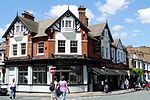Royal Naval College, Greenwich
1873 establishments in England1998 disestablishments in the United KingdomEducational institutions disestablished in 1998EngvarB from October 2013Grade I listed buildings in the Royal Borough of Greenwich ... and 5 more
History of the Royal Borough of GreenwichMilitary history of LondonRoyal Naval College, GreenwichStaff collegesTraining establishments of the Royal Navy

The Royal Naval College, Greenwich, was a Royal Navy training establishment between 1873 and 1998, providing courses for naval officers. It was the home of the Royal Navy's staff college, which provided advanced training for officers. The equivalent in the British Army was the Staff College, Camberley, and the equivalent in the Royal Air Force was the RAF Staff College, Bracknell.
Excerpt from the Wikipedia article Royal Naval College, Greenwich (License: CC BY-SA 3.0, Authors, Images).Royal Naval College, Greenwich
King William Walk, London East Greenwich (Royal Borough of Greenwich)
Geographical coordinates (GPS) Address Website Nearby Places Show on map
Geographical coordinates (GPS)
| Latitude | Longitude |
|---|---|
| N 51.482222222222 ° | E -0.0066666666666667 ° |
Address
Old Royal Naval College
King William Walk
SE10 9HX London, East Greenwich (Royal Borough of Greenwich)
England, United Kingdom
Open on Google Maps








